MITSUBISHI iMiEV 2016 1.G Manual PDF
Manufacturer: MITSUBISHI, Model Year: 2016, Model line: iMiEV, Model: MITSUBISHI iMiEV 2016 1.GPages: 296, PDF Size: 7.79 MB
Page 71 of 296

MiEV Remote System
General information/Charging 3-57
3
N01203600019
1. Gently wipe with gauze or a
nother soft cloth soaked with a mild soap and water solution.
2. Wipe off all the detergent with a soft clot
h dipped in fresh water and thoroughly wrung out.
3. Wipe all moisture off and dry in
a shaded, well-ventilated area.
The Remote Cli- mate Control can-not be activated.
After the power/commu- nication switch is pressed, the following symbol blinks in several seconds. ERROR symbol
Any of the door or liftgate is ope
n. Close all the door
s and liftgate.
The selector lever is
at the position other
than P (PARK).
Place the selector lever to P (PARK) position.
Quick charging is in progress. (The symbol will illuminate.)
quick charging completes.
The temperature of the Main Drive Lith- ium-ion Battery has exceeded about 140 °F (60 °C).
Allow the temperature of the Main Drive Lithium- ion Battery to reach norm
al operating temperature.
Refer to “Cautions and acti
on to deal with intense
heat” on page 3-8.
The Remote Climate Control is not activated.
The electric motor switch has been oper- ated before the system is charged.
Check whether the electric motor switch has been operated before the system is charged.
The temperature of the Main Drive Lith- ium-ion Battery has exceeded about 140 °F (60 °C).
Allow the temperature of the Main Drive Lithium- ion Battery to reach norm
al operating temperature.
Refer to “Cautions and acti
on to deal with intense
heat” on page 3-8.
The Remote Cli- mate Control can- not be activated.
The heated seat is not powered on.
The heated seat switch is turned off. Turn on the heated seat switch.
The heated seat becomes hot while the air condi- tioning (cooling) is acti- vated.
The heated seat switch is turned on. Turn off the heated seat switch.
Cleaning the MiEV Remote
Phenomena
Cause
Remedy
BK0220401US.book 57 ページ 2015年6月3日 水曜日 午前7時42分
Page 72 of 296

MiEV Remote System 3-58 General information/Charging
3
CAUTION Never use benzine, petrol, or ot
her organic solvents, or acid or
alkaline solvents. Doing so c
ould cause deformation, discolor,
or malfunction. Also, these
substances may be present in various cl
eaners, so check carefully before use.
BK0220401US.book 58 ページ 2015年6月3日 水曜日 午前7時42分
Page 73 of 296
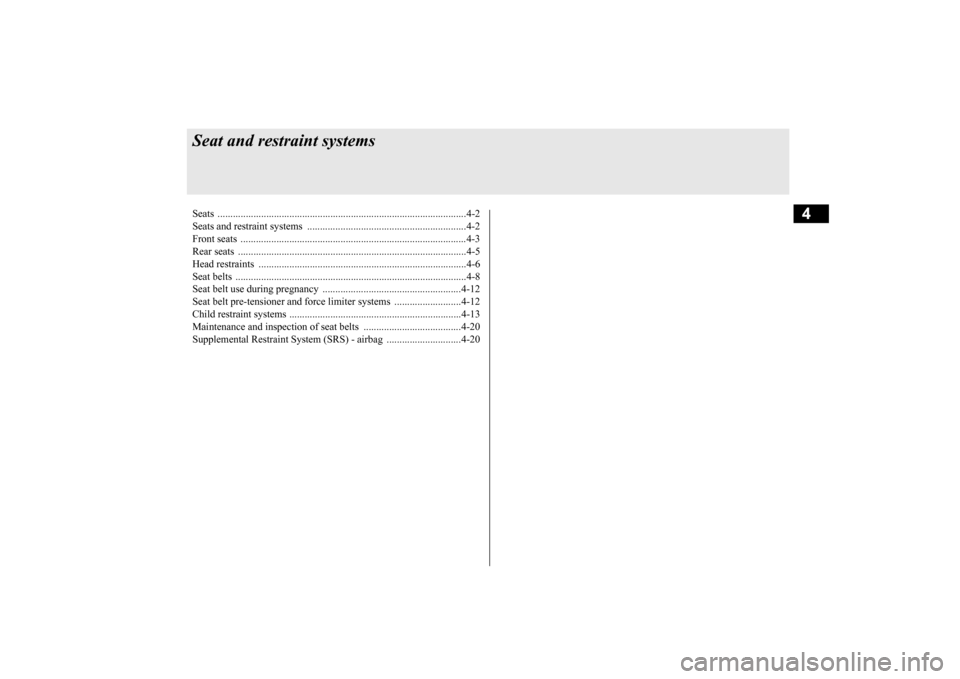
4
Seat and restraint systemsSeats .................................................................................................4-2 Seats and restraint systems ..............................................................4-2 Front seats ........................................................................................4-3Rear seats .........................................................................................4-5 Head restraints .................................................................................4-6 Seat belts ..........................................................................................4-8Seat belt use during pregnancy ......................................................4-12 Seat belt pre-tensioner and force limiter systems ..........................4-12 Child restraint systems ...................................................................4-13Maintenance and inspection of seat belts ......................................4-20 Supplemental Restraint Syst
em (SRS) - airbag ......
.........
.........
.....4-20
BK0220401US.book 1 ページ 2015年6月3日 水曜日 午前7時42分
Page 74 of 296
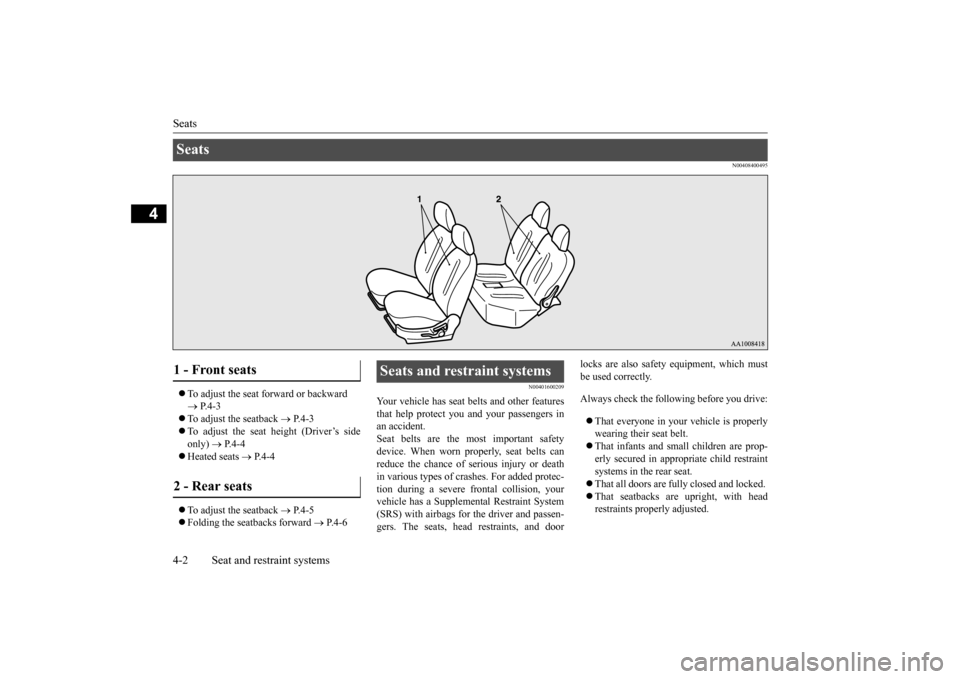
Seats 4-2 Seat and restraint systems
4
N00408400495
To adjust the seat forward or backward P.4-3
To adjust the seatback
P.4-3
To adjust the seat
height (Driver’s side
only)
P.4-4
Heated seats
P. 4 - 4
To adjust the seatback
P.4-5
Folding the seatbacks forward
P.4-6
N00401600209
Your vehicle has seat belts and other features that help protect you and your passengers in an accident.Seat belts are the most important safety device. When worn properly, seat belts can reduce the chance of serious injury or deathin various types of cras
hes. For added protec-
tion during a severe fr
ontal collision, your
vehicle has a Supplemen
tal Restraint System
(SRS) with airbags for the driver and passen- gers. The seats, head restraints, and door
locks are also safety equipment, which must be used correctly. Always check the following before you drive: That everyone in your vehicle is properly wearing their seat belt. That infants and small children are prop- erly secured in appropriate child restraintsystems in the rear seat. That all doors are fully closed and locked. That seatbacks are upright, with head restraints properly adjusted.
Seats 1 - Front seats 2 - Rear seats
Seats and restraint systems
BK0220401US.book 2 ページ 2015年6月3日 水曜日 午前7時42分
Page 75 of 296
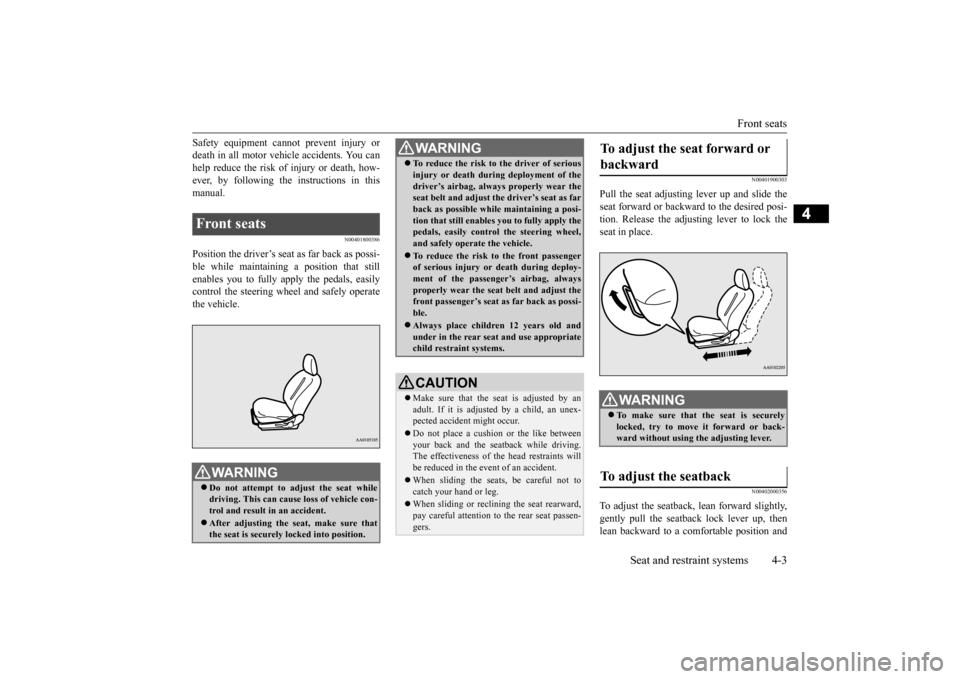
Front seats
Seat and restraint systems 4-3
4
Safety equipment cannot prevent injury or death in all motor vehi
cle accidents. You can
help reduce the risk of injury or death, how- ever, by following the instructions in this manual.
N00401800386
Position the driver’s seat
as far back as possi-
ble while maintaining a position that still enables you to fully apply the pedals, easily control the steering wh
eel and safely operate
the vehicle.
N00401900303
Pull the seat adjusting lever up and slide theseat forward or backwa
rd to the desired posi-
tion. Release the adjusting lever to lock the seat in place.
N00402000356
To adjust the seatback,
lean forward slightly,
gently pull the seatback lock lever up, then lean backward to a comfortable position and
Front seats
WA R N I N G Do not attempt to adjust the seat while driving. This can cause loss of vehicle con- trol and result
in an accident.
After adjusting the se
at, make sure that
the seat is securely locked into position.
To reduce the risk to the driver of serious injury or death during deployment of thedriver’s airbag, always
properly wear the
seat belt and adjust th
e driver’s seat as far
back as possible while maintaining a posi- tion that still enables
you to fully apply the
pedals, easily control the steering wheel, and safely operate the vehicle. To reduce the risk to the front passenger of serious injury or
death during deploy-
ment of the passeng
er’s airbag, always
properly wear the seat
belt and adjust the
front passenger’s seat as far back as possi- ble. Always place childr
en 12 years old and
under in the rear seat
and use appropriate
child restraint systems.CAUTION Make sure that the seat is adjusted by an adult. If it is adjusted by a child, an unex- pected accident might occur. Do not place a cushion
or the like between
your back and the seatback while driving. The effectiveness of the head restraints willbe reduced in the event of an accident. When sliding the seats, be careful not to catch your hand or leg. When sliding or reclining the seat rearward, pay careful attention to
the rear seat passen-
gers.WA R N I N G
To adjust the seat forward or backward
WA R N I N G To make sure that the seat is securely locked, try to move
it forward or back-
ward without using th
e adjusting lever.
To adjust the seatback
BK0220401US.book 3 ページ 2015年6月3日 水曜日 午前7時42分
Page 76 of 296
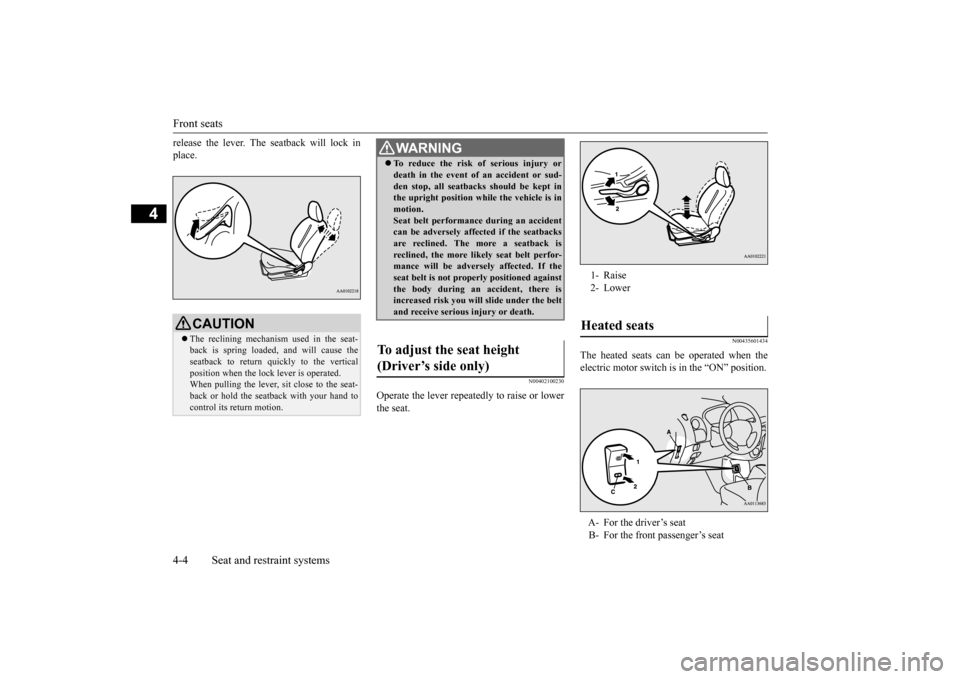
Front seats 4-4 Seat and restraint systems
4
release the lever. The seatback will lock in place.
N00402100230
Operate the lever repeatedly to raise or lowerthe seat.
N00435601434
The heated seats can
be operated when the
electric motor switch is in the “ON” position.
CAUTION The reclining mechanism used in the seat- back is spring loaded, and will cause the seatback to return quickly to the verticalposition when the lock
lever is operated.
When pulling the lever, sit close to the seat- back or hold the seatback with your hand tocontrol its return motion.
WA R N I N G To reduce the risk of serious injury or death in the event of
an accident or sud-
den stop, all seatbacks should be kept inthe upright position while the vehicle is in motion. Seat belt performance during an accidentcan be adversely affect
ed if the seatbacks
are reclined. The more a seatback is reclined, the more likely seat belt perfor-mance will be advers
ely affected. If the
seat belt is not prop
erly positioned against
the body during an accident, there isincreased risk you will slide under the belt and receive serious
injury or death.
To adjust the seat height (Driver’s side only)
1- Raise 2- Lower Heated seats A- For the driver’s seat B- For the front passenger’s seat
BK0220401US.book 4 ページ 2015年6月3日 水曜日 午前7時42分
Page 77 of 296

Rear seats
Seat and restraint systems 4-5
4
The indicator light (C) will illuminate while the heater is on.
N00402500218
N00402800022
To adjust the seatback,
lean forward slightly,
gently pull the seatback lock lever, then lean backward to a comfortable position and release the lever. The seatback will lock inplace.
1- Heater on. 2- Heater offWA R N I N G Persons who are unable to feel tempera- ture change or skin
pain due to age, ill-
ness, injury, medication, alcohol use, fatigue or other phys
ical conditions or
who have sensitive sk
in may suffer burns
when using the heated seat even at low temperatures. To reduce the risk of burns,people with such conditions must use care when using the heated seat.CAUTION Switch off the seat heater when not in use.Do not place heavy objects on the seat or stick pins, needles, or
other pointed objects
into the seat. Do not place a blanket,
cushion, or other
insulating material on the seat while usingthe heater; doing so can
cause the heater ele-
ment to overheat. When cleaning the seat, do not use benzine, kerosene, gasoli
ne, alcohol, or other organic
solvents; doing so can cause damage not only to the surface of the seat, but also to theheater.
If water or any other li
quid is spilled on the
seat, allow it to dry thoroughly beforeattempting to use the heater. Turn the heater off immediately if it appears to be malfunctioning during use.NOTE
Do not turn the electric motor switch to the “ON” position; doing
so will stop quick
charging. You can use the heated seats while the Remote Climate Control is activated. Refer to “Remote Climate Control” on page 3-36, 3-47 and “For persons with electro-medical apparatus such
as implantable car-
diac pacemaker or im
plantable cardiovascu-
lar defibrillator” on page 3-6.
Rear seats
CAUTION Child restraint lower anchorages (A) are pro- vided between the seat
cushion and the seat-
back. Be careful that the lower anchorages may be hot due to heat of th
e electric motor unit
room.CAUTION
To adjust the seatback
BK0220401US.book 5 ページ 2015年6月3日 水曜日 午前7時42分
Page 78 of 296
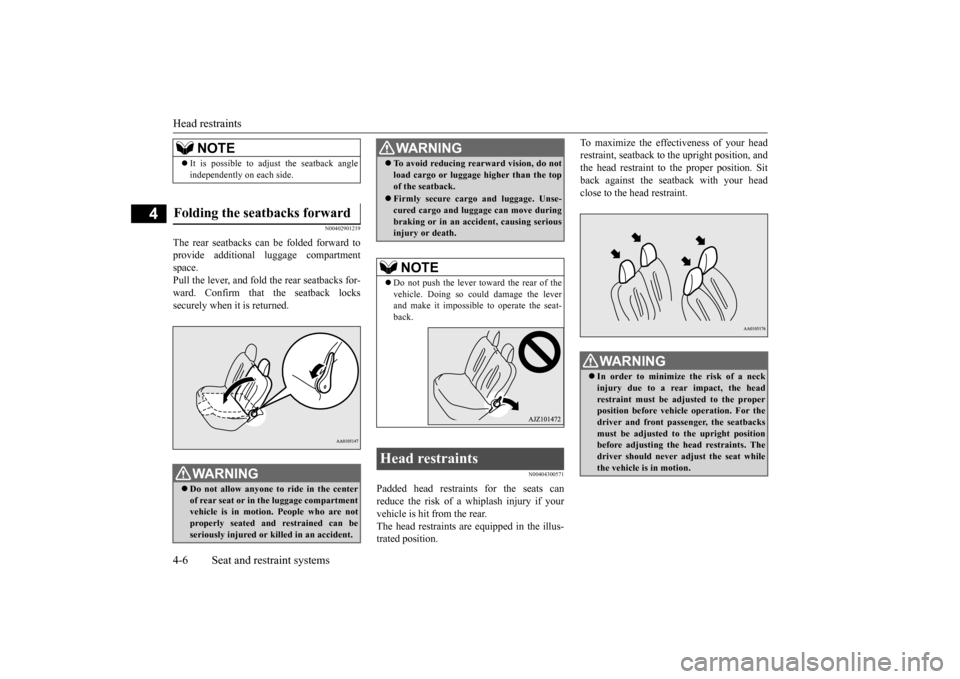
Head restraints 4-6 Seat and restraint systems
4
N00402901219
The rear seatbacks can be folded forward to provide additional l
uggage compartment
space. Pull the lever, and fold the rear seatbacks for- ward. Confirm that the seatback lockssecurely when it is returned.
N00404300571
Padded head restraints for the seats canreduce the risk of a whiplash injury if yourvehicle is hit from the rear. The head restraints are equipped in the illus- trated position.
To maximize the effectiveness of your head restraint, seatback to
the upright position, and
the head restraint to the proper position. Sit back against the seatback with your head close to the head restraint.
NOTE
It is possible to adjust the seatback angle independently on each side.
Folding the seatbacks forward
WA R N I N G Do not allow anyone to ride in the center of rear seat or in the luggage compartment vehicle is in motion
. People who are not
properly seated and restrained can beseriously injured or ki
lled in an accident.
To avoid reducing rearward vision, do not load cargo or luggage
higher than the top
of the seatback. Firmly secure car
go and luggage. Unse-
cured cargo and luggage
can move during
braking or in an acci
dent, causing serious
injury or death.NOTE
Do not push the lever toward the rear of the vehicle. Doing so c
ould damage the lever
and make it impossible
to operate the seat-
back.
Head restraints
WA R N I N G
WA R N I N G In order to minimize the risk of a neck injury due to a rear impact, the head restraint must be adjusted to the properposition before vehicl
e operation. For the
driver and front passenger, the seatbacks must be adjusted to the upright positionbefore adjusting the head restraints. The driver should never ad
just the seat while
the vehicle is in motion.
BK0220401US.book 6 ページ 2015年6月3日 水曜日 午前7時42分
Page 79 of 296
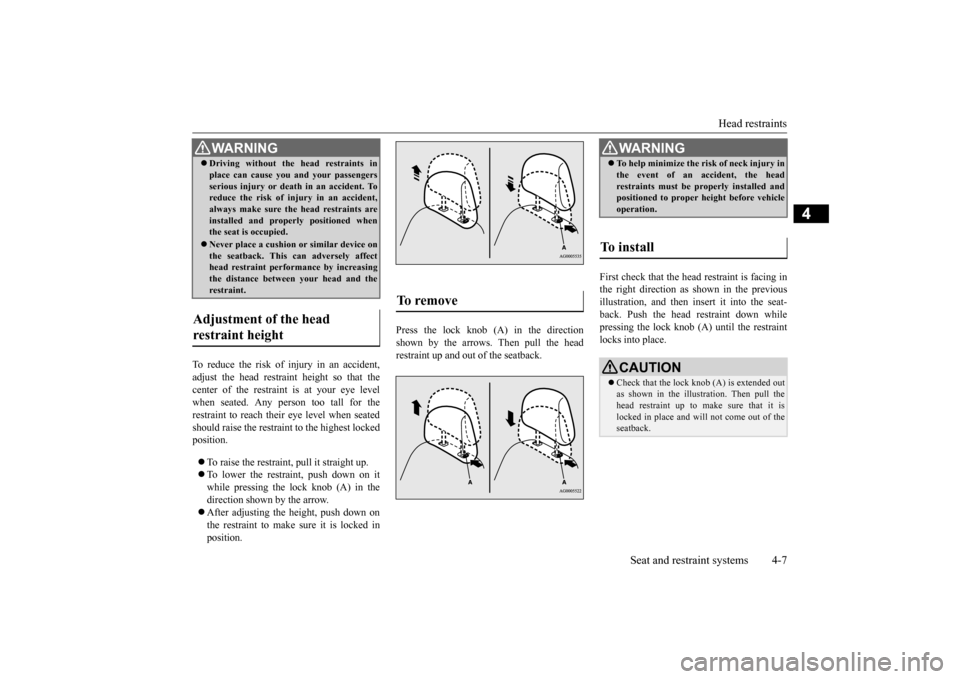
Head restraints
Seat and restraint systems 4-7
4
To reduce the risk of injury in an accident, adjust the head restraint height so that the center of the restraint is at your eye level when seated. Any person too tall for therestraint to reach their eye level when seated should raise the restrain
t to the highest locked
position. To raise the restraint,
pull it straight up.
To lower the restraint, push down on it while pressing the lock knob (A) in the direction shown by the arrow. After adjusting the height, push down on the restraint to make sure it is locked in position.
Press the lock knob (A) in the direction shown by the arrows. Then pull the head restraint up and out of the seatback.
First check that the head restraint is facing in the right direction as shown in the previousillustration, and then insert it into the seat- back. Push the head
restraint down while
pressing the lock knob (A
) until the restraint
locks into place.
Driving without the head restraints in place can cause you and your passengersserious injury or deat
h in an accident. To
reduce the risk of injury in an accident, always make sure the head restraints are installed and properly positioned whenthe seat is occupied. Never place a cushion
or similar device on
the seatback. This can adversely affect head restraint performance by increasing the distance between your head and therestraint.
Adjustment of the head restraint height
WA R N I N G
To remove
WA R N I N G To help minimize the risk of neck injury in the event of an accident, the headrestraints must be properly installed andpositioned to proper height before vehicle operation.
To install
CAUTION Check that the lock knob (A) is extended out as shown in the illustration. Then pull the head restraint up to make sure that it is locked in place and will not come out of theseatback.
BK0220401US.book 7 ページ 2015年6月3日 水曜日 午前7時42分
Page 80 of 296
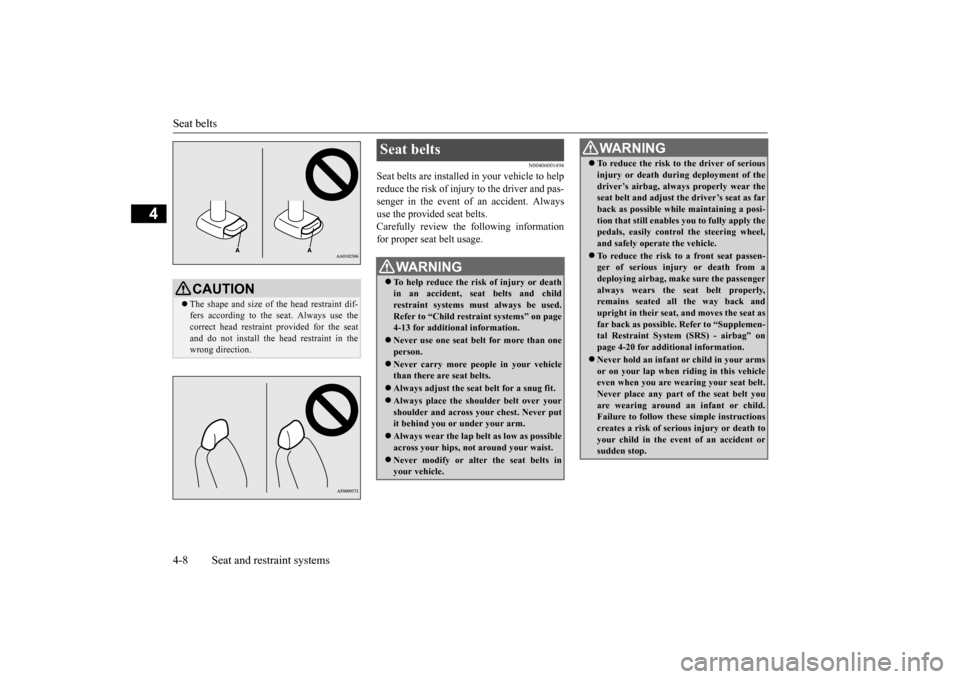
Seat belts 4-8 Seat and restraint systems
4
N00406001494
Seat belts are installed
in your vehicle to help
reduce the risk of injury to the driver and pas- senger in the event of an accident. Alwaysuse the provided seat belts. Carefully review the following information for proper seat belt usage.
CAUTION The shape and size of the head restraint dif- fers according to the seat. Always use thecorrect head restraint provided for the seat and do not install the he
ad restraint in the
wrong direction.
Seat belts
WA R N I N G To help reduce the risk of injury or death in an accident, se
at belts and child
restraint systems must always be used. Refer to “Child restraint systems” on page4-13 for additional information. Never use one seat belt for more than one person. Never carry more peop
le in your vehicle
than there are seat belts. Always adjust the seat belt for a snug fit.Always place the shou
lder belt over your
shoulder and across
your chest. Never put
it behind you or
under your arm.
Always wear the lap belt as low as possible across your hips, not around your waist. Never modify or alter the seat belts in your vehicle.
To reduce the risk to the driver of serious injury or death duri
ng deployment of the
driver’s airbag, always
properly wear the
seat belt and adjust th
e driver’s seat as far
back as possible while maintaining a posi- tion that still enables
you to fully apply the
pedals, easily control the steering wheel, and safely operate the vehicle. To reduce the risk to a front seat passen- ger of serious injury or death from a deploying airbag, make sure the passengeralways wears the seat belt properly, remains seated all the way back and upright in their seat,
and moves the seat as
far back as possible. Refer to “Supplemen- tal Restraint System (SRS) - airbag” on page 4-20 for additional information. Never hold an infant
or child in your arms
or on your lap when ri
ding in this vehicle
even when you are we
aring your seat belt.
Never place any part of the seat belt you are wearing around an infant or child.Failure to follow these simple instructions creates a risk of serious injury or death to your child in the event of an accident orsudden stop.WA R N I N G
BK0220401US.book 8 ページ 2015年6月3日 水曜日 午前7時42分